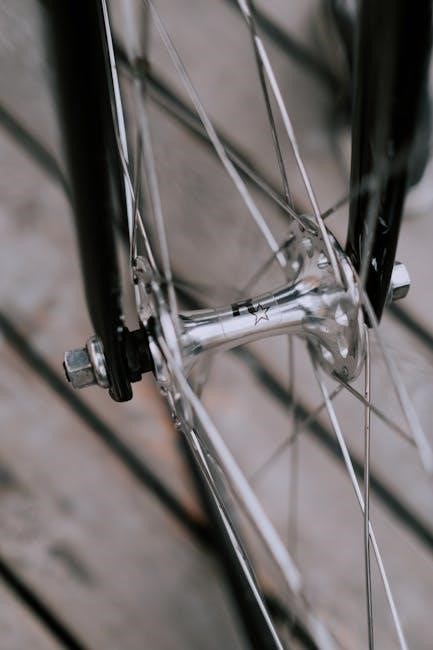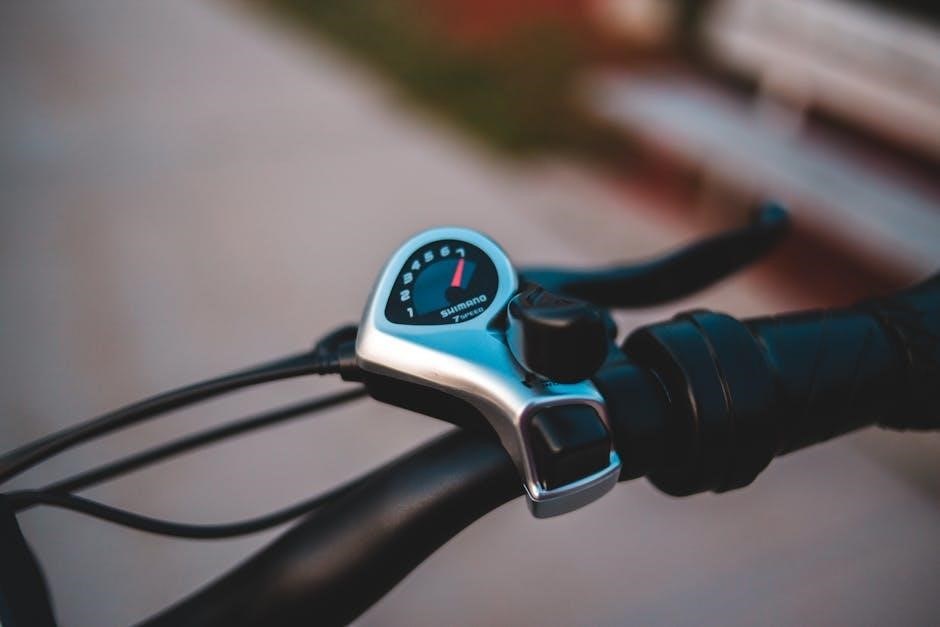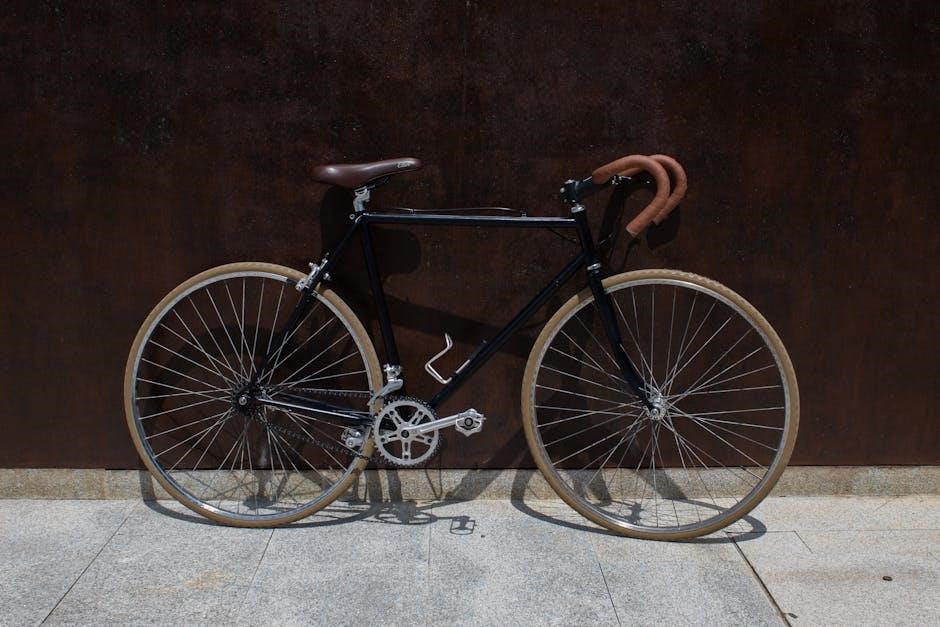Welcome to the E-Bike Controller Manual! This guide provides essential information for understanding, installing, and maintaining your e-bike’s controller․ It ensures optimal performance and safety․
1․1 What is an E-Bike Controller?
An e-bike controller is the central electronic component that manages power distribution between the motor, battery, and user inputs․ Acting as the “brain” of the e-bike, it processes signals from the throttle, brakes, and pedals to regulate motor speed and torque․ The controller ensures efficient energy use, smooth operation, and safety by controlling how much power is delivered to the motor․ Modern controllers often include advanced features like speed limiting, torque sensing, and communication interfaces for connectivity․ Proper functioning of the controller is critical for optimal performance and rider safety․
1․2 Importance of the Controller in an E-Bike
The controller is crucial for optimizing performance and safety in an e-bike․ It manages power distribution between the motor, battery, and user inputs like throttle and brakes․ By regulating energy flow, it prevents overload and ensures smooth operation․ A well-configured controller enhances the riding experience by providing consistent power delivery and responsiveness․ This makes the e-bike more reliable and enjoyable, ensuring it operates within safe parameters․ Understanding its role helps users appreciate its significance in maintaining efficiency and overall functionality․
1․3 Purpose of the Manual
This manual serves as a comprehensive guide for e-bike owners, technicians, and enthusiasts․ It provides detailed instructions for installing, configuring, and maintaining the controller․ The manual also covers troubleshooting common issues and optimizing performance․ By following the guidelines, users can ensure safety, reliability, and peak functionality of their e-bike․ Whether you’re a novice or an experienced user, this manual offers clear, step-by-step information to help you understand and manage your e-bike controller effectively, ensuring a seamless and enjoyable riding experience․

Understanding the Components of an E-Bike Controller
The e-bike controller acts as the brain, managing power distribution, sensor inputs, and communication between components․ It ensures smooth operation, efficiency, and safety by coordinating all electrical systems․
2․1 Overview of the Controller
The e-bike controller is a central electronic unit that manages the flow of power and coordination between the motor, battery, and other components․ It acts as an intermediary, interpreting inputs from the throttle, brakes, and sensors to deliver the appropriate power output․ The controller ensures efficient energy use, smooth acceleration, and consistent performance․ By regulating voltage and current, it protects the system from overloads and faults․ Modern controllers also incorporate advanced features like torque sensing and communication interfaces for enhanced functionality․ Understanding its role is crucial for optimizing your e-bike’s operation and longevity․
2․2 Key Components: Power Stage, Microcontroller, and Sensors
The controller consists of three primary components: the power stage, microcontroller, and sensors․ The power stage includes MOSFETs or IGBTs that regulate high-current flow to the motor, ensuring efficient power delivery․ The microcontroller acts as the brain, processing inputs and executing control algorithms․ Sensors monitor critical parameters like speed, torque, and battery voltage, providing real-time data for precise control․ Together, these components work in harmony to optimize performance, safety, and reliability, enabling seamless interaction between the rider and the e-bike system․
2․3 Throttle and Brake Inputs
The throttle and brake inputs are essential for controlling the e-bike’s operation․ The throttle sends a signal to the controller, determining the desired power output based on rider input․ Brake inputs, often connected to levers, communicate with the controller to cut power to the motor and activate regenerative braking if enabled․ These inputs ensure smooth acceleration and secure stopping․ Proper setup and calibration of these components are critical for safe and responsive handling, allowing the controller to interpret rider intentions accurately and adjust the e-bike’s behavior accordingly․
2․4 Communication Interfaces (e․g․, CAN Bus, UART)
Communication interfaces like CAN Bus and UART enable data exchange between the controller and other e-bike components․ CAN Bus is a high-speed, reliable protocol for real-time communication, while UART provides a simpler serial connection for basic data transfer․ These interfaces allow the controller to integrate with sensors, displays, and other systems, ensuring seamless operation․ Proper configuration of these interfaces is vital for optimal performance, enabling the controller to process inputs and outputs efficiently․ They also support advanced features like diagnostics and firmware updates, making them integral to modern e-bike systems․

Installation and Setup of the E-Bike Controller
Installing and setting up your e-bike controller requires careful planning and attention to detail․ This section guides you through selecting the right controller, wiring, and initial configuration to ensure compatibility, safety, and optimal performance․ Follow the step-by-step instructions to avoid errors and guarantee a smooth setup process․ Proper installation is critical for reliability and efficiency, so take your time and use the right tools for the job․ This section also covers essential safety precautions and best practices for a successful setup․
3․1 Choosing the Right Controller for Your E-Bike
Selecting the appropriate controller for your e-bike is crucial for optimal performance and safety․ Consider factors such as your bike’s voltage, current, and power requirements․ Ensure compatibility with your motor type, whether it’s a hub or mid-drive․ Additionally, think about features like waterproofing, Bluetooth connectivity, and programmable settings․ The controller’s capacity to handle peak power and continuous power should match your riding style and terrain․ Always check reviews and manufacturer specifications to make an informed decision․ The right controller will enhance your e-bike’s efficiency, reliability, and overall riding experience․
3․2 Step-by-Step Installation Guide
Begin by disconnecting the battery to ensure safety․ Mount the controller in a secure, dry location, ideally near the battery for minimal wiring․ Connect the motor, throttle, and brakes, following the wiring diagram․ Ensure all sensors are properly linked and secured․ Reconnect the battery and turn on the system to test basic functions․ Double-check all connections for tightness and integrity․ Refer to the wiring diagram for specific pin assignments․ Finally, test the e-bike at low speed to confirm proper operation․ Always wear protective gear during installation and testing․
3․3 Wiring Diagrams and Connections
Wiring diagrams are essential for connecting the controller to your e-bike’s components․ Start by identifying the battery, motor, and throttle connections․ Use the diagram to match terminals, ensuring proper polarity and voltage․ Connect the brake sensors and pedal-assist sensors if applicable․ Secure all wires with heat shrink tubing or connectors․ Verify that the CAN Bus or UART connections are correctly linked for communication․ Double-check the wiring before powering on the system to avoid short circuits․ Refer to the diagram for specific pin assignments and color-coding guidelines․ Proper connections ensure safe and efficient operation․
3․4 Initial Setup and Configuration
Welcome to the initial setup and configuration section․ Begin by powering on the controller and checking for any fault codes on the LCD display․ Ensure all connections are secure and properly configured․ Use the provided software or buttons to set basic parameters like assist levels, speed limits, and throttle sensitivity․ Calibrate the brake and throttle inputs to ensure smooth operation․ Refer to the manual for default settings or customize based on your preferences․ Save your configurations and test the system at low power to verify functionality․ Proper setup ensures optimal performance and safety․

Configuration and Programming
This section guides you through configuring and programming your e-bike controller to optimize performance, safety, and customization․ Learn to adjust settings and explore advanced features for enhanced riding experiences․
4․1 Understanding the Controller’s Software
The controller’s software acts as the brain of your e-bike, managing power delivery, speed limits, and safety features․ It processes inputs from sensors and user commands to optimize performance․ Customizable parameters like acceleration, torque, and speed can be adjusted through the software․ Understanding the software is crucial for tailoring your e-bike’s behavior to your riding style․ It also enables real-time monitoring of systems and firmware updates․ Familiarizing yourself with the software ensures seamless operation and allows you to unlock advanced features for a personalized experience․
4․2 Adjusting Parameters: Speed, Acceleration, and Torque
Adjusting parameters like speed, acceleration, and torque allows you to customize your e-bike’s performance․ Speed settings control the maximum velocity, while acceleration determines how quickly power is delivered․ Torque settings influence the motor’s pulling power, especially useful for hills․ These adjustments can be made via the controller’s software or a compatible display unit․ Proper tuning ensures a smooth, efficient ride tailored to your preferences․ Always follow safety guidelines and local regulations when modifying these settings to avoid exceeding legal limits or compromising stability․
4․3 Programming Custom Settings
Programming custom settings on your e-bike controller allows you to tailor its behavior to your riding style․ Using specialized software or a compatible display, you can modify settings like pedal assist sensitivity, power levels, and speed limits․ Customizing these parameters ensures a personalized experience, optimizing efficiency and performance․ Always refer to the controller’s manual for specific instructions, as procedures may vary by model․ Backup your current settings before making changes to avoid data loss․ Experiment carefully to achieve the perfect balance between power and control for your e-bike adventures․
4․4 Calibrating the Controller
Calibrating your e-bike controller ensures optimal performance and reliability․ This process aligns the controller with the motor, sensors, and other components․ Begin by connecting the controller to the manufacturer’s software or using the e-bike’s display interface․ Follow the on-screen instructions to initialize the calibration process․ This typically involves resetting default settings, synchronizing the motor, and testing throttle and brake inputs․ After calibration, take a short test ride to ensure smooth operation․ If issues persist, refer to the manual or contact a professional for assistance․ Proper calibration is crucial for safety and efficiency․

Operation and Safety Precautions
Welcome to the Operation and Safety Precautions section of your e-bike controller manual․ Ensure safe and optimal performance by following these essential guidelines carefully every time․
5․1 Basic Operating Instructions
Always start by ensuring the e-bike is on a flat surface and in a safe environment․ Turn on the system using the power button․ Use the throttle smoothly to avoid sudden acceleration․ Apply brakes gradually to maintain control, especially at higher speeds․ Monitor the control panel for battery level, speed, and error codes․ Avoid extreme weather conditions unless your e-bike is designed for such use․ Keep loose clothing tied back and wear protective gear․ Follow local traffic rules and ensure proper visibility․ Shut down the system properly after use to conserve battery life and maintain optimal performance․
5․2 Safety Guidelines for Riders
Always wear protective gear, including a helmet, gloves, and reflective clothing, to ensure visibility and safety․ Conduct a pre-ride check of brakes, tires, and battery․ Avoid sudden acceleration or sharp turns, as they can lead to loss of control․ Stay alert and aware of your surroundings, following all traffic laws․ Keep loose clothing secure to prevent entanglement with moving parts․ Avoid riding in extreme weather conditions unless your e-bike is specifically designed for such use․ Carry a phone or emergency kit for unexpected situations․ Never exceed the recommended weight limit or carry unauthorized passengers․ Ride defensively and stay within legal speed limits to minimize risks․
5․3 Emergency Procedures
In case of an emergency, such as a system failure or loss of control, immediately cut off power to the controller using the designated switch․ Engage the mechanical brakes firmly and bring the e-bike to a safe stop․ If the bike experiences a sudden malfunction, remain calm and avoid panic․ Assess the situation and check for any visible damage or loose connections․ If the issue persists, do not attempt to ride the bike; instead, contact a professional or the manufacturer for assistance․ In the event of a crash, turn off the power and ensure you are not injured before moving․ Always prioritize safety and follow proper emergency protocols to minimize risks․

Troubleshooting Common Issues
Identify and resolve common e-bike controller issues, such as power faults, sensor malfunctions, and connectivity problems․ This section provides step-by-step solutions to ensure smooth operation․
6․1 Identifying Common Problems
Common issues with e-bike controllers include error codes, connectivity problems, and sensor malfunctions․ Riders may experience unexpected cutoffs, reduced power, or complete system failures․ Faulty wiring, worn components, or software glitches often cause these problems․ Monitoring error codes and unusual behavior helps in early detection․ Regular inspections of connections, sensors, and battery health are crucial․ Identifying these issues promptly prevents further damage and ensures safe operation․ Always refer to the error code list and diagnostic tools provided in this manual for accurate troubleshooting․
6․2 Error Codes and Their Meanings
Error codes are essential for diagnosing issues with your e-bike controller․ Common codes include E01 (battery fault), E02 (motor malfunction), and E03 (sensor failure)․ Each code corresponds to specific problems, helping you identify the root cause․ For example, E10 may indicate a communication error between components, while E20 could signal a thermal overload․ Always refer to the error code list in this manual for detailed explanations․ Understanding these codes allows for quick troubleshooting and ensures your e-bike operates safely and efficiently․ If unsure, consult the troubleshooting section or contact a professional․
6․3 Diagnosing Electrical Issues
Diagnosing electrical issues with your e-bike controller involves a systematic approach․ Start by identifying symptoms, such as intermittent power or error codes․ Check all wiring connections and connectors for damage or corrosion․ Use a multimeter to verify voltage at key points, ensuring it matches specifications․ Test for continuity between components and ground․ Isolate the controller from other parts and check for short circuits․ If issues persist, consult the error code list or perform advanced tests using diagnostic tools․ Always ensure safety by disconnecting the battery before performing detailed electrical checks․ Regular inspections can prevent many electrical faults from escalating․
6․4 Diagnosing Mechanical Issues
Diagnosing mechanical issues with your e-bike controller involves inspecting physical components and their connections․ Start by checking the motor, brakes, and sensors for wear or damage․ Ensure proper alignment and secure mounting of all parts․ Test throttle and brake levers for smooth operation and verify sensor responsiveness․ Inspect cables and connectors for fraying or corrosion․ Use a multimeter to check for continuity in wiring․ Perform a test ride to identify unusual behavior, such as jerky acceleration or inconsistent braking․ Addressing mechanical issues promptly prevents further damage and ensures reliable performance․ Regular inspections can help catch problems early․
6․5 When to Seek Professional Help
If you encounter complex issues beyond basic troubleshooting, such as persistent error codes, motor malfunctions, or severe electrical faults, it’s best to seek professional assistance․ Damage to the controller, throttle, or sensors that requires soldering or advanced repair should be handled by a qualified technician․ Additionally, if you’re unsure about diagnosing or repairing issues, consult a professional to avoid causing further damage․ Experts have the tools and knowledge to address intricate problems, ensuring your e-bike operates safely and efficiently․ Don’t hesitate to reach out when you’re out of your depth to maintain your e-bike’s performance and longevity․

Maintenance and Upkeep
Regular maintenance is crucial for your e-bike controller’s longevity․ Clean the unit, inspect for wear, update firmware, and ensure secure connections to prevent issues and optimize performance․
7․1 Regular Maintenance Schedule
To ensure optimal performance and longevity, establish a maintenance routine․ Inspect the controller monthly for dust, moisture, or loose connections․ Clean the unit with a soft brush or compressed air every 3 months․ Check for firmware updates quarterly and install them as needed․ Annually, have a professional inspect the controller’s electrical components․ Store the e-bike in a dry, cool place during extended periods of inactivity․ Regular maintenance prevents malfunctions and extends the controller’s lifespan, ensuring reliable operation and safety․
7․2 Cleaning and Inspecting the Controller
Clean the controller regularly to prevent dust and moisture buildup․ Use a soft, dry cloth or compressed air to gently remove debris from the exterior and vents․ Avoid liquids or harsh chemicals, as they may damage components․ Inspect connectors and wires for signs of wear or corrosion․ Check for loose connections and secure them if necessary․ Visually examine the circuit board for any physical damage or burn marks․ Proper cleaning and inspection ensure the controller operates efficiently and prevents potential failures, maintaining your e-bike’s performance and safety on the road․
7․3 Updating Firmware
Updating your e-bike controller’s firmware ensures you have the latest features, bug fixes, and performance enhancements․ Start by downloading the newest firmware version from the manufacturer’s website․ Use the provided software tool or mobile app to connect to the controller, typically via USB or Bluetooth․ Follow the step-by-step instructions carefully to avoid interruptions․ Do not turn off the power or disconnect during the update․ After completion, test the e-bike to confirm proper functionality․ Regular firmware updates optimize performance, improve safety, and enhance your overall riding experience․

Legal and Regulatory Considerations
Understanding and adhering to local e-bike laws, safety regulations, and insurance requirements is crucial to ensure legal operation and rider safety on public roads and trails․
8․1 Compliance with Local E-Bike Laws
Compliance with local e-bike laws is essential to ensure legal and safe operation․ Regulations vary by region, often specifying speed limits, power output, and allowable trails․ Familiarize yourself with local ordinances to avoid penalties․ Some jurisdictions require e-bikes to meet specific safety standards, such as braking systems or lighting․ Additionally, modifications to your e-bike’s controller or motor may affect compliance․ Always verify that your e-bike meets local regulations before operation․ Failure to comply can result in fines or legal consequences, undermining the safety and enjoyment of your e-bike experience․
8․2 Registration and Licensing Requirements
Registration and licensing requirements for e-bikes vary by region․ Some jurisdictions require e-bikes to be registered, while others may demand a license to operate them․ Check local regulations to determine if your e-bike falls under specific categories, such as Class 1, 2, or 3 e-bikes, which may have different requirements․ Age restrictions may also apply․ Failure to comply with registration or licensing laws can result in fines or penalties․ Always verify with your local Department of Motor Vehicles (DMV) or equivalent authority to ensure your e-bike meets all legal standards for operation․
8․3 Insurance and Liability
Insurance and liability considerations are crucial for e-bike owners․ While not all regions require e-bike insurance, having coverage can protect against accidents, theft, or damage․ Some home or renters insurance policies may cover e-bikes, but specialized e-bike insurance often provides better protection․ Liability insurance is particularly important, as it covers damages or injuries caused to others in an accident․ Check with insurance providers to find a policy that suits your needs․ Understanding liability laws in your area is also essential to avoid legal complications․ Always carry proof of insurance if required by law․

Advanced Customization and Modifications
This section explores advanced techniques to optimize your e-bike’s performance through hardware upgrades, software tuning, and accessory integration․ Discover how to enhance functionality and personalize your ride․
9․1 Hardware Modifications for Enhanced Performance
Hardware modifications can significantly boost your e-bike’s performance․ Upgrading components like MOSFETs, capacitors, or adding a heatsink can improve efficiency and reliability․ However, modifications require careful planning and expertise to avoid damaging the controller or causing safety hazards․ Always ensure compatibility and consult diagrams or professional guidance before making changes․ Proper tools and a clean workspace are essential to prevent electrical issues․ Start with small upgrades, such as replacing resistors or adding cooling fans, and test thoroughly․ Safety should always be your top priority when modifying your e-bike’s hardware․
9․2 Software Modifications and Hacking
Software modifications involve tweaking or reprogramming the controller’s firmware to unlock advanced features or optimize performance․ This can include adjusting torque curves, increasing speed limits, or enabling custom ride modes․ However, hacking requires technical expertise and specialized tools to avoid damaging the controller or causing system instability․ Always use trusted software sources and backup your current firmware before making changes․ Improper modifications can void warranties or lead to safety issues․ Proceed with caution and consider consulting forums or professionals for guidance․ Testing modifications in a controlled environment is highly recommended․
9․3 Adding Accessories and Upgrades
Upgrading your e-bike with accessories can enhance functionality and personalized performance․ Common upgrades include advanced displays, integrated lights, and custom handlebar controls․ Accessories like GPS, phone mounts, and cargo carriers can improve convenience․ When adding upgrades, ensure compatibility with your controller and e-bike system․ Always follow manufacturer guidelines to avoid electrical or software conflicts․ Testing new additions in a safe environment is recommended․ Upgrades can significantly improve your riding experience, offering better control, visibility, and comfort․ Consider professional installation for complex modifications to ensure reliability and safety․
Mastering your e-bike controller ensures optimal performance, safety, and longevity․ By following this manual, you’ll achieve enhanced riding experiences, efficiency, and enjoyment․ Regular maintenance is key to preserving your e-bike’s functionality and extending its lifespan․ Always refer to this guide for troubleshooting and customization needs․ Safe riding and happy trails ahead!
10․1 Summary of Key Points
This manual has covered essential aspects of e-bike controllers, from understanding their components to advanced customization․ It emphasized proper installation, configuration, and maintenance to ensure reliability and safety․ Troubleshooting techniques and legal considerations were also addressed to provide a comprehensive guide․ By following the outlined steps and best practices, riders can optimize their e-bike performance, extend its lifespan, and enjoy a seamless riding experience․ Refer to this manual regularly for updates and to refine your skills in managing and enhancing your e-bike controller․
10․2 Final Tips for Optimal Use
For optimal use of your e-bike controller, always follow the manufacturer’s guidelines and perform regular inspections․ Ensure proper wiring connections and keep the controller clean and dry․ Avoid extreme temperatures and overloading the system․ Ride safely by adhering to local laws and being mindful of road conditions․ Update firmware periodically to access new features and improvements․ Monitor battery levels and adjust settings to balance performance and efficiency․ Lastly, store your e-bike in a secure, dry location when not in use to maintain its longevity and functionality․

References and Further Reading
For further understanding, refer to your e-bike manufacturer’s official manual and technical specifications․ Explore industry publications and online forums dedicated to e-bike electronics․ Consult IEEE standards for electric vehicles and EBIC standards for e-bike components․ Visit reputable websites like Electrek or EbikeTips for in-depth guides․ Additionally, consider books on electric vehicle design and controller systems for advanced insights․ Join e-bike communities and forums for peer-to-peer advice and troubleshooting tips․ Always ensure sources are credible and up-to-date for reliable information․
